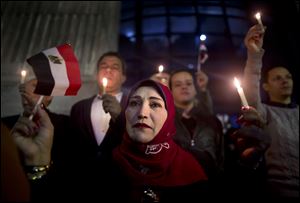
EDITORIAL
A blueprint for peace in the Middle East
11/27/2017
People take part during a candlelight vigil as they hold national flag for victims of a Friday mosque attack at the Journalists Syndicate, in Cairo, Egypt.
At a mosque in Egypt’s Sinai Peninsula, a terrorist attack has left more than 300 people dead and about 100 more wounded. It is the bloodiest single attack since conflict flared in the North Sinai region six years ago.
Over the past three decades or so, almost every country in the Middle East has seen death and suffering on a scale that both Christian and Muslim cultures compare to their religions’ metaphysical places of torment — Hell or Jahannam.
Click here to view more Blade editorials
Today the Christian West has largely escaped the kind of hell that emerges from intra-faith doctrinal disputes. During what was perhaps the worst of these hells — the Thirty Years’ War — the Middle East was enjoying a long period of relative peace under the Ottoman Empire. Now the roles are reversed, with the Middle East rent by sectarian violence.
The treaty that ended the Thirty Years’ War also effectively ended the European wars of religion. That settlement may have something to teach leaders today.
In an article that appeared in the October, 2016, issue of Foreign Affairs, titled “A Westphalian Peace for the Middle East,” two experts on the region, Michael Axworthy and Patrick Milton, argue that the principles behind the Peace of Westphalia could solve many of the problems facing the Middle East.
The principles are threefold. The first involves “limiting the sovereignty of most states or rulers in the region by giving a degree of protection to citizens against their own rulers.”
The second principle is recognizing that peace will only last if “external guarantors collectively enforce respect among states for their people’s basic rights of religion, property, and due process.”
The third principle derived from the European experience could be for the Middle East to determine its own “normative year.”
Under the Peace of Westphalia, the borders between the kingdoms of the Holy Roman Empire, as well as the rights of their minority confessional groups, were reset to what they were on Jan. 1, 1624. These terms guaranteed a minimum level of rights and protections for minority groups and prohibited the exclusion of a subject or citizen from civic office on the basis of religion. The authors acknowledge that now in the Middle East as then in Europe, selecting a normative year would be contentious, but applied “judiciously and flexibly” it could be “a useful tool in peacemaking.”
The Peace of Westphalia was successful not because it eradicated infra-faith conflict, but because it moved it into legal rather than military arenas. Such a conflict resolution process would require Middle Eastern states to give up a measure of sovereignty, a bargain few would be willing to make as yet, but the only real alternative to endless violence.